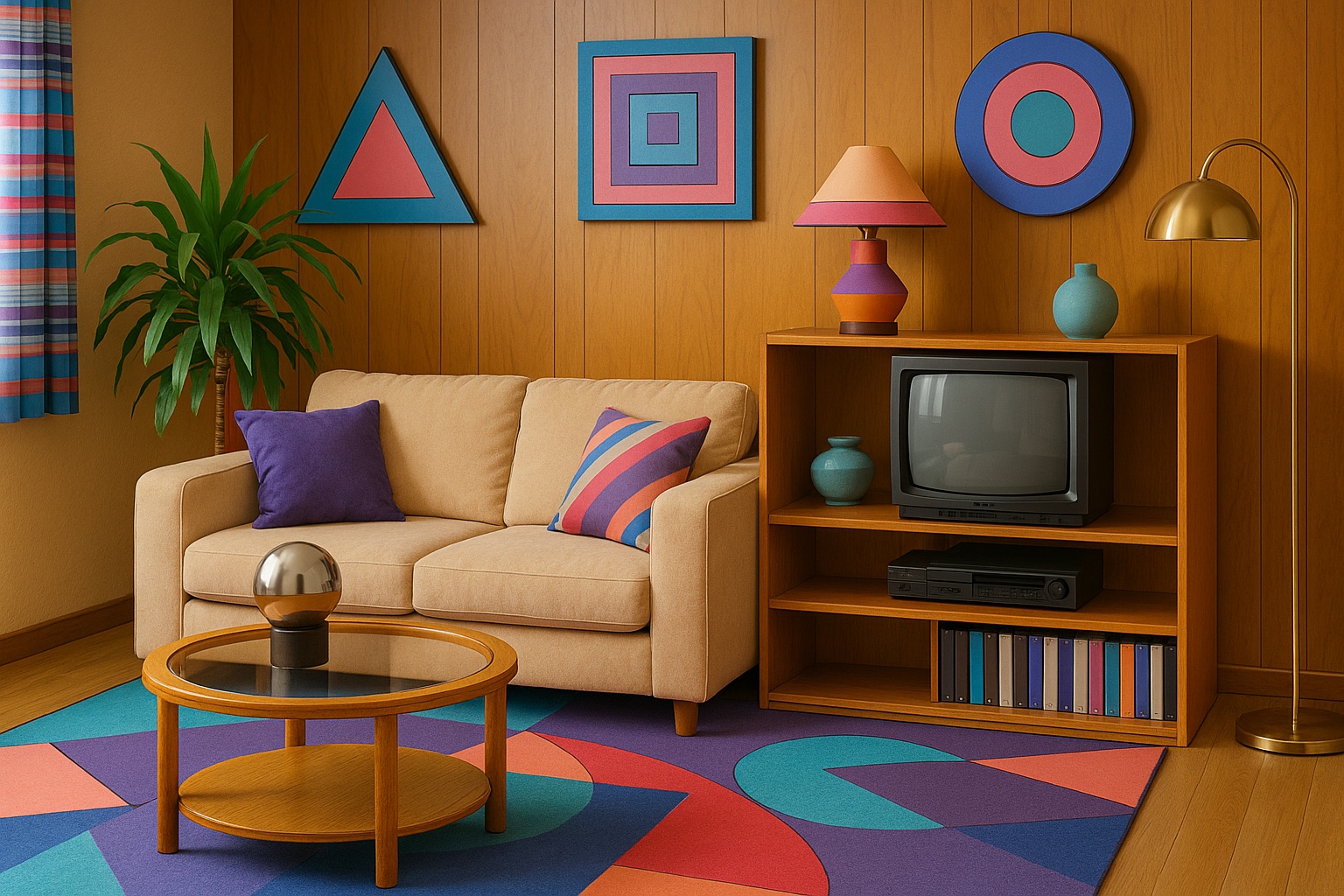1980s Decor is staging a stylish return in 2025, as retro interiors take over thrift stores, Instagram feeds, and even high-end design magazines. With its bold geometry, glossy finishes, and unapologetic flair, the era of excess is charming a new generation of homeowners, collectors, and thrifters.
Why 1980s Decor Is Trending Again
The sudden revival of 1980s aesthetics isn’t a coincidence—it’s a blend of cultural nostalgia, design rebellion, and social media inspiration. Here’s why the thrift world can’t get enough:
- Pop Culture Resurgence: Hit shows like Stranger Things and American Horror Story: 1984 have reignited interest in retro aesthetics.
- Thrifting Renaissance: Sustainability-driven shoppers are embracing secondhand decor with character and craftsmanship.
- Unique Statement Pieces: From neon lamps to glass-block tables, 80s decor stands out in a sea of beige minimalism.
- Social Media Trends: TikTok and Instagram reels filled with #80sDecor hauls and room tours are inspiring Gen Z and Millennials alike.
- High-Low Design Appeal: Designers now pair thrifted finds with modern elements for curated, not cluttered, interiors.
What Defines 1980s Interior Style?
While the 1980s were infamous for shoulder pads and synthesizers, the design world embraced just as much drama. The decade’s interiors were bold, glamorous, and experimental:
- Memphis Design: Abstract shapes, asymmetry, and bright contrasting colors
- Lacquer & Chrome: Shiny surfaces, black-gloss cabinetry, mirrored walls, and tubular metal furniture
- Pastel + Neon: Bubblegum pink, mint green, lavender — often combined with electric blue or yellow accents
- Glass and Lucite: Transparent materials added futuristic and space-age vibes to coffee tables, shelving, and chairs
In 2025, 1980s Decor isn’t just back — it’s being reimagined with purpose and personality.
Top 1980s Decor Items That Are Back in Demand
If you’re heading to a flea market or browsing online, keep an eye out for these 1980s Decor gems. These pieces are not only stylish—they’re also rising in value:
| Item | Description | Where to Find | Resale Value |
|---|---|---|---|
| Lacquered Sideboards | Glossy black or white storage pieces with gold or chrome trim | Estate sales, Craigslist, thrift chains | $300–$1,200+ depending on condition |
| Glass Block Tables | Sculptural coffee or end tables with stacked glass block bases | Facebook Marketplace, architectural salvage stores | $250–$800 |
| Memphis Lamps | Colorful geometric table or floor lamps, often Italian or reissued | Etsy, Chairish, vintage boutiques | $150–$1,000+ |
| Modular Wall Units | Sleek shelving and storage systems with smoked glass or laminate | Retro consignment shops, local auctions | $400–$2,000 |
| Lucite Chairs | Clear acrylic seating with brass or chrome accents | eBay, upscale thrift stores | $200–$900 each |
“The 1980s were unapologetically bold, and that’s exactly what today’s buyers crave—statement pieces with personality and provenance.” — Carla Lin, vintage reseller
To distinguish originals from modern replicas, look for brand stamps (e.g., Drexel Heritage, Baughman), materials like real lacquer or Lucite, and aged hardware. Many thrifted finds can be cleaned or lightly restored to their original glory—and often for a fraction of their resale price.
How to Style 1980s Decor in a Modern Home
Integrating 1980s Decor into your space doesn’t mean turning your home into a retro time capsule. The key is blending vintage flair with modern sensibility. Here are expert-approved tips to strike that balance:
- Start with one hero piece: A lacquered sideboard or Lucite coffee table can make a bold statement without overwhelming the space.
- Balance with neutral tones: Pair pastel or neon pieces with beige, gray, or earthy walls and textiles to avoid visual chaos.
- Mix in organic textures: Combine 1980s chrome and gloss with wood, rattan, or linen for a modern-retro mix.
- Layer in small accents: Ceramic sculptures, VHS artwork, or glass ashtrays add period flavor without commitment.
- Use symmetry and simplicity: Avoid clutter by arranging bold shapes in clean, curated compositions.
Tips for Thrifting 1980s Finds
Finding authentic, affordable pieces takes patience and strategy. Use these tips to score the best vintage treasures:
- Check condition carefully: Look for chips, rust, loose joints, or missing trim before buying—especially with lacquer or Lucite.
- Know your designers: Learn to spot names like Karl Springer, Milo Baughman, and Pace Collection on labels or signatures.
- Bargain at garage sales: Many sellers undervalue 1980s items—don’t hesitate to negotiate respectfully.
- Use saved searches: Set alerts on eBay, Facebook Marketplace, and OfferUp using keywords like “postmodern,” “80s chrome,” or “Memphis style.”
Whether you’re a maximalist or minimalist, the 1980s offer more than nostalgia—they bring personality and joy back into design.
FAQs
- Is 1980s furniture valuable?
Yes. High-end 1980s pieces—especially from designers like Karl Springer or companies like Drexel—have surged in resale value as collectors and decorators seek rare postmodern styles. - How can I tell if a thrifted item is really from the 80s?
Check for dated tags, labels, or stamps. Materials like chrome, laminate, and Lucite were dominant, as were geometric or pastel designs. Look up markings or serial numbers when in doubt. - Where’s the best place to find 1980s Decor?
Start with local estate sales, Goodwill outlets, and Facebook Marketplace. For curated selections, try Etsy, Chairish, or eBay with specific search filters like “1980s modern” or “Memphis style.” - Can I mix 1980s Decor with modern furniture?
Absolutely. The key is moderation—use one or two focal pieces and balance them with neutral tones and modern shapes to create harmony, not chaos. - Is it better to buy original 1980s items or replicas?
Originals offer historical value and better craftsmanship, but replicas can be budget-friendly and easier to maintain. Many designers now recreate 80s aesthetics with a modern twist.
Conclusion
1980s Decor has found new life in 2025—fueled by nostalgia, creativity, and a growing love for statement interiors. This thrift-fueled comeback isn’t just about looks; it’s about telling stories, preserving design history, and building spaces that feel bold and personal.
Whether you’re collecting lacquered sideboards, scouting for Lucite chairs, or just curious about the Memphis movement, there’s no better time to embrace the past with a modern eye. Start small, shop smart, and let the 80s back into your home—one conversation piece at a time.












